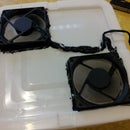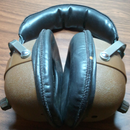Introduction: X-Arcade USB-B Joystick Driver Upgrade
I have had these X-Arcade solo controllers for a number of years and initially was using them for a PC Mame setup in my living room but quickly came to the conclusion that the original design is just not that practical for longevity or extreme playing (ie. button mashing).
Mainly, the original design of these uses a keyboard driver which means every button is assigned to a letter on the keyboard and the computer will recognize it as keystrokes. PC's recognize keystrokes sequentially, so if 3 buttons are hit at the same time from a joystick, the computer will put them in an order they were received. When playing fighting games with 2 people and button mashing occurs the computer won't keep up with the chain of signals so fighting moves that require tricky button combinations won't be completed.
Additionally, the original ports on these are PS2 (PC keyboard, not playstation 2) and Serial ports so if you lose the original cables or if the cable breaks you'll have to order another one from X-Arcade.
At one point they had upgraded their X-Arcade boards with an additional mode for USB joystick (https://support.xgaming.com/support/solutions/articles/12000051721-tri-mode-pcb) and offered updated boards on their site for $40. After the installation of the new boards however the back of the controllers will have the serial and ps2 ports dangling outside.
Over the last couple of years my brother-in-law and I have been building little Retro-Pie setups for friends and family which gave me the idea to simply replace the X-Arcade board with an updated USB board that are commonly used in custom fighter sticks or home arcade cabinet builds.
I'm documenting this process for anyone else that has had come across the similar issues I described here.
Supplies
Here are the parts that I have ordered:
- Reyann Zero Delay Arcade USB Encoder ($9.48 at time of writing this article):
- Right angle adapter ($7.99 at time of writing this article):
Step 1: Opening the Controller, Removing the Wiring and Board
The pictures here are for an X-Arcade Solo however these same steps can likely be performed to some similar degree on the other models of controllers they have.
Remove the screws from the bottom and use a flathead screw diver to lift the bottom. This is the original wiring layout here.
Remove the wire leads from each of the switches and follow them back to the molex connections on the board to remove them entirely.
The mode switch will have a few wires soldered directly into it. Cut these at the nodes as this switch will not be used after the upgrade.
Cut the wires for the LED that's glued to the top of the controller, red and brown. Tape these leads down with masking tape in case you want to use the LED for later.
Remove the wiring harness and proceed to unscrew the X-Arcade controller board from the block of wood.
Clean out the space if needed.
Step 2: Installing the New Board and USB-B Jack
Wedge in the USB-B right-angle adapter and then glue it in place with hot glue. The wedge and hot glue will prevent the USB-B jack from being pushed into the case. Should, at least.
Screw in the new USB encoder board using the same screws that the X-Arcade board was screwed in with. These are wood screws so I didn't bother drilling guide holes but you may if you're more comfortable with doing so.
Follow the paperwork that the USB encoder comes with and proceed to wire up each of the buttons. Some of the wires in my kit were not long enough so I spliced them with other wire to make them long enough, particularly the Up and 11 buttons.
Step 3: Button Layout
Here is the diagram I used for my button layout. Feel free to adjust this if you have a different preference of button layout.
Also I will note that button 10 here can be used for Select or Insert Coin. Originally this was a mode select button which wasn't usable in game play so this upgrade adds an additional button for your setup!
Please remember when working from the bottom of the controller that your buttons will essentially be backwards from this diagram. Also note of what switches are hit when you move the joystick in the different directions.
Step 4: Cleaning Up the Wiring
Use zip-ties to group and consolidate the wiring. Before replacing the bottom panel I would suggest hooking the controller up to a computer to test all of the buttons.
Windows has a USB joystick controller checker in the control panel that can be searched for easily. Mac and Linux users can test the buttons in the Mame configuration menu.
If everything works fine then screw in the bottom panel and test them again.
Step 5: Done!
Pros of doing this modification:
- USB-B cables can be purchased cheaply and as long as needed!
- PCs will recognize the controllers as USB Joysticks so multiple inputs can be read without lag!
- Retro Pie and other custom projects will recognize the controller without too much customization!
- Other PC games will recognize this controller!












